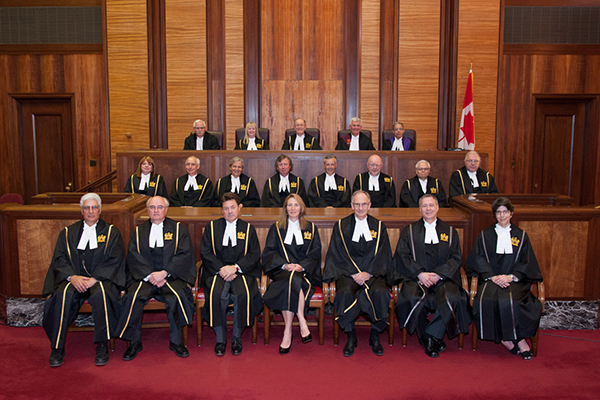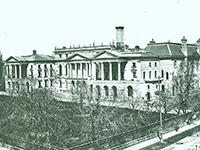CANADA HISTORY - Politics-Elections
Supreme Court
The Court System of Canada: A Comprehensive Overview
The Canadian court system is a complex and integral part of the nation's democratic and legal framework, structured to ensure fairness, justice, and the rule of law. This system consists of multiple levels of courts, with distinct roles and responsibilities, addressing federal and provincial jurisdictions. It functions as the backbone of the country's legal structure, resolving disputes, interpreting laws, and upholding constitutional principles. To fully understand the Canadian court system, one must explore the division between federal and provincial courts, the different levels of courts, how judges are appointed, and how the courts operate within Canada’s legal and constitutional framework.
Origins and Development of the Canadian Court System
The roots of Canada’s court system stretch back to the colonial period, where early legal structures were influenced by English and French legal traditions. With Confederation in 1867, the British North America Act (now the Constitution Act, 1867) established a federal system of government that also defined the judicial responsibilities between the federal and provincial governments. Section 92(14) of the Constitution Act gave provinces authority over the "administration of justice" within their boundaries, including the creation of courts, while Section 101 granted the federal government the power to establish a general court of appeal and any other additional courts necessary for federal purposes.
Canada's judicial system has evolved significantly since Confederation. The Supreme Court of Canada was established in 1875 as the country's highest court, and since then, the structure has been continuously refined to adapt to the changing legal needs of the nation. The foundation of the court system rests on principles derived from both common law (from England) and civil law (from France, particularly in Quebec), making it unique in its operation across the provinces and territories.
The Role of Courts in Canada
The primary role of courts in Canada is to resolve disputes between individuals, governments, or entities by interpreting and applying the law. This includes both civil matters (such as contracts, property disputes, and family law issues) and criminal matters. Courts also play a crucial role in constitutional interpretation, ensuring that all laws and government actions comply with the Canadian Charter of Rights and Freedoms (part of the Constitution Act, 1982) and other constitutional provisions.
The courts are vital in upholding the rule of law, ensuring that no one is above the law, and providing a system where all individuals can have their rights adjudicated. The judiciary functions independently from the executive and legislative branches of government, a principle that safeguards impartiality and fairness.
The Hierarchy of Courts in Canada
The Canadian court system is divided into several levels, forming a hierarchical structure that allows for appeals and specialized jurisdictions. The main levels of the Canadian court system include:
1. Provincial and Territorial Courts (Lower Courts)
Each province and territory has its own lower courts, which handle the bulk of criminal, civil, and family law cases. These courts serve as the entry point for most legal disputes. They include:
Provincial/Territorial Courts: These are courts of first instance, dealing with less serious criminal offenses, family law matters (except divorce), traffic violations, small claims, and regulatory offenses. They do not have jurisdiction over the most serious criminal offenses or complex civil matters.
Specialized Courts: Some provinces have specialized courts within the provincial court system that deal with specific areas of law, such as family law courts, youth courts (dealing with young offenders), mental health courts, and drug treatment courts. These courts address the particular needs of individuals in specific circumstances and apply a more focused approach to legal issues.
Small Claims Courts: These are designed to resolve civil disputes involving smaller sums of money. The process is usually simpler, faster, and less formal than higher courts.
2. Superior Courts of the Provinces and Territories
Superior courts operate at a higher level and have broad jurisdiction over both criminal and civil matters. Each province and territory has a superior court, and their names may vary (e.g., Ontario Superior Court of Justice or the Court of Queen’s Bench in Alberta). Superior courts have the authority to hear more serious criminal cases, major civil disputes, and family law matters such as divorce and child custody.
Criminal Jurisdiction: Superior courts try the most serious criminal offenses, including murder and other indictable offenses. They may also handle appeals from decisions made by lower provincial courts.
Civil Jurisdiction: In civil matters, superior courts deal with more significant disputes, including those involving larger financial amounts or complex legal issues. These courts also hear appeals from administrative tribunals.
Family Jurisdiction: Superior courts deal with divorce proceedings and the more complicated aspects of family law, including division of property, spousal support, and child custody.
3. Provincial and Territorial Courts of Appeal
Each province and territory also has a court of appeal, which reviews decisions made by lower courts and superior courts. These appellate courts have the power to overturn or modify decisions based on errors of law or procedural fairness. Appeals can involve both civil and criminal cases.
Courts of appeal do not generally retry cases or hear new evidence; instead, they review the record from the trial court to determine whether legal errors affected the outcome. Appellate decisions often provide key legal interpretations and contribute significantly to the development of Canadian case law.
4. The Federal Court System
The federal court system operates parallel to provincial courts and deals with matters that fall under federal jurisdiction, as outlined in the Constitution Act, 1867. Federal courts have jurisdiction over cases related to federal law, such as immigration, intellectual property, tax law, and disputes involving the federal government.
Federal Court: This court handles a wide range of federal issues, including immigration, patents, and cases involving the federal government. It also reviews decisions made by federal administrative tribunals.
Federal Court of Appeal: This court hears appeals from the Federal Court and certain federal tribunals. It deals with the interpretation of federal laws and regulations, ensuring uniformity across Canada in areas of federal jurisdiction.
Tax Court of Canada: This specialized court hears disputes between taxpayers and the federal government regarding tax matters.
5. The Supreme Court of Canada
The Supreme Court of Canada is the highest court in the country and serves as the final appellate court for all legal matters, including constitutional, civil, and criminal cases. Established in 1875, it ensures consistency and coherence in the interpretation of laws across the country.
The Supreme Court’s role extends beyond being a court of last resort; it plays a crucial part in shaping national legal principles, particularly in interpreting the Canadian Charter of Rights and Freedoms. The court also hears reference questions, where the federal government or provincial governments ask for legal opinions on important constitutional or legislative matters.
Federal vs. Provincial Jurisdiction in Canada
One of the key distinctions in Canada’s judicial system is the division between federal and provincial jurisdiction. While the provinces have authority over the administration of justice and civil and criminal matters within their borders, certain areas are reserved exclusively for the federal government.
The federal courts handle cases related to federal laws and matters of national importance, while provincial courts deal with issues within the provincial domain, such as property, civil rights, and local matters. However, even in criminal law, which is legislated federally through the Criminal Code, provincial courts have jurisdiction over the majority of criminal trials.
Appointment of Judges in Canada
The process of judicial appointment in Canada is carefully structured to maintain judicial independence, a critical component of the rule of law. Judges in Canada are appointed by both the federal and provincial governments, depending on the level of court.
Superior Court Judges: Judges in superior courts, provincial courts of appeal, and the Supreme Court of Canada are appointed by the federal government. The Governor General, on the advice of the Prime Minister and Cabinet, formally makes these appointments, but they are often based on recommendations from a judicial advisory committee.
Provincial Court Judges: Judges for provincial and territorial courts (lower courts) are appointed by the provincial governments. Each province and territory has its own process for selecting and appointing judges, often relying on judicial advisory committees to assess potential candidates.
The appointment process is designed to ensure that judges are selected based on merit and legal expertise, rather than political considerations. Judges in Canada serve until the mandatory retirement age of 75.
How the Courts Operate
Courts in Canada operate under an adversarial system, where two opposing parties present their case to an impartial judge (and sometimes a jury), who evaluates the evidence and applies the law to reach a decision. The principles of fairness, transparency, and justice guide courtroom proceedings.
In criminal cases, the Crown (the state) prosecutes individuals accused of crimes, and the accused has the right to defend themselves, with legal representation if desired. In civil cases, individuals or organizations bring legal claims against one another, seeking a resolution to disputes.
The Canadian legal system also incorporates significant procedural safeguards, such as the right to a fair trial, the presumption of innocence in criminal cases, and access to legal representation. These protections are enshrined in the Canadian Charter of Rights and Freedoms and are crucial to ensuring that the courts operate justly and fairly.
Conclusion
Canada’s court system is a fundamental part of its democratic framework, ensuring that justice is administered impartially and fairly across the country. The division of federal and provincial courts reflects the country's federalist structure, with the courts serving as guardians of both federal and provincial laws. The process of appointing judges helps maintain judicial independence, while the layered structure of trial courts, appellate courts, and the Supreme Court ensures that all Canadians have access to justice at multiple levels.
The Canadian court system, built on centuries of legal evolution, continues to play a vital role in the protection of rights, the interpretation of laws, and the promotion of justice, ensuring that all individuals are subject









